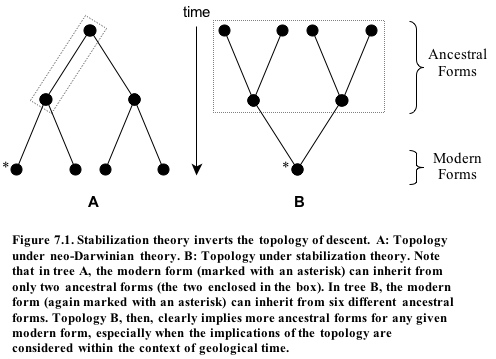On the Origins of New Forms of Life
7.9: Point Mutations
EUGENE M. MCCARTHY, PHD GENETICS
|
|
(Continued from the previous page)
Even if consideration is limited to random point mutations not directly caused by stabilization processes, stabilization theory paints a more plausible picture of evolution than does orthodox theory. Under that view of evolution, the presumed prevalence of hybridization, makes it common for any given type of organism to have two distinct types of parents. Parental forms, too, would often be derived from two distinct parental forms of their own, and so forth, back through time. With this repeated doubling, the number of ancestral forms for any given modern form would be huge. The descendant form could inherit a mutation occurring in any one of these ancestors. On the other hand, under neo-Darwinian theory, the number of ancestral forms is far smaller (see Figure 7.1). Therefore the number of inheritable mutations is also far smaller. Thus, under stabilization theory, it is much easier to understand how the accumulation of point mutations might play a significant role in evolution (the chance that such a mutation would occur would greatly increase if the number of ancestral individuals were so much larger). The accumulation would not, however, occur within a single isolated lineage. Instead, it would occur within multiple, hybridizing lineages. So this assumption inverts the topology of descent (see Figure 7.1).
 |
However, under stabilization theory, point mutations play no direct role in the production of new stable forms, as do chromosomal mutations. The evolution of genes is decoupled from the production of new forms. Alteration of genes through point mutation is viewed as an ongoing process occurring within populations composed of individuals that are largely uniform and stable over time. Gradual statistical changes are therefore assumed to occur in genes. But the typical form is assumed to come into being abruptly and change little thereafter. The theory says it is only as one form succeeds another over geological time that point mutations, which occasionally produce new traits, begin to have major effect as they accumulate within a lineage of forms (see Section 8). In contrast, neo-Darwinian theory assumes point mutations typically do have a major effect (by accumulating within a lineage of individuals in the successive generations of a single isolated population). Stabilization theory claims the accumulation of point mutations does not usually lead gradually to the production of new forms. Instead such a mutations are conceived of as arising within populations of individuals that already share a particular karyotype and a particular stable set of characteristic traits. Typically they do not alter the essential features that characterize form. Only when that form goes on to produce an offspring form, can that mutation become part of the genome of a new form. Even then, it is the genetic events that occur during the stabilization process producing that new form that determine the new form's characteristic features.